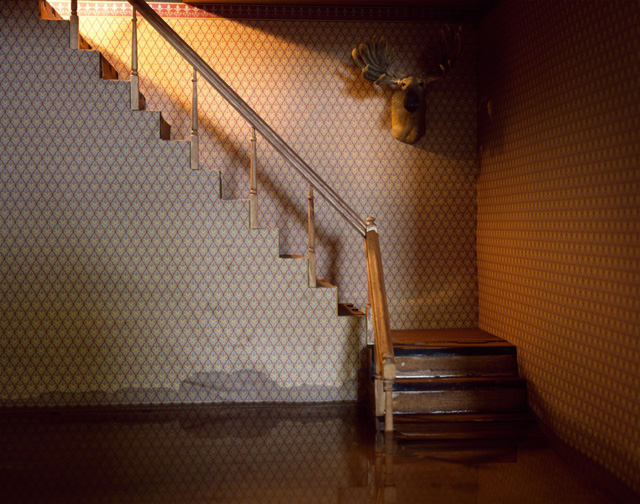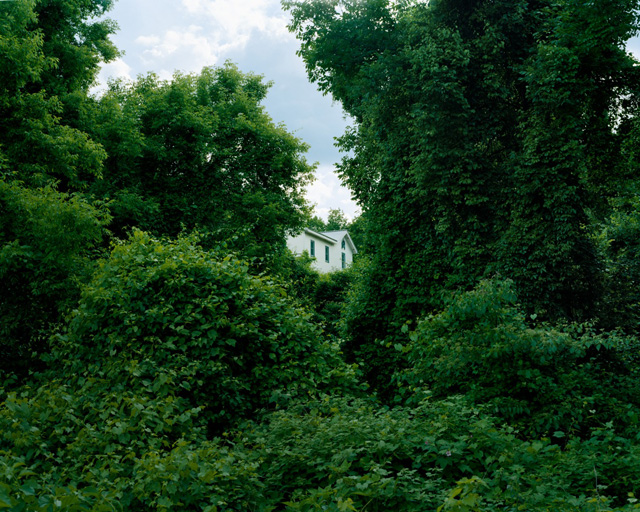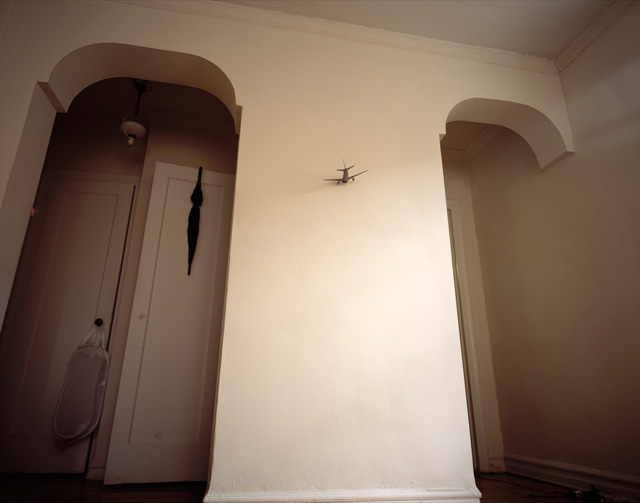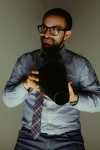Showcase: Yoav Friedländer
Yoav Friedländer is an “Americanized” Israeli. He was born and raised between Jerusalem and the Dead Sea. His art is composed of mediated American culture, desert landscapes of childhood, and war.
Interviewed by Marinos Tsagkarakis
Edited by Chiara Costantino

Yoav, how did you come to photography?
I have two distinct first memories of coming into photography. When I was really little, 5 or 6 years old, my parents had let me take some photographs and I remember being told that I constantly cropped the heads of the people I shot by accident, and that became a huge concern for me as a child. The second memory, which continues to play a big role in my life, is of me at the age of 8 staging a picture that I’ve asked my father to take. There was a stream of water crossing a picnic area and I wanted my father to photograph me jumping over and across the water. The picture I had in mind was kind of heroic, and I was obviously aware already at the time to the perspective of photography on reality. I’ve waited anxiously for the film to return from the photo shop just to discover a harsh disappointment when the picture I was jumping over the water was nothing like what I have imagined. I was small, shot from above and the stream of water seemed even smaller compared to its surroundings. Ever since I became obsessed with photography. I blamed as a child the cheap point and shoot camera that my family had for the disappointing image and every time I was walking by a camera store I would stand in front of the window display and examine the large professional cameras with their lenses fantasizing what magical photographs I would have captured with them. Even though my entire childhood was based on film cameras, the first camera I owned was a digital one, which I started using during junior high than high school, through my army service and into my BA in photography. I got into photography with the misconception that the camera is responsible for making wonderful photographs, like the ones I’ve always imagined, and slowly learned that it is the photographic perspective through which we adapt to see the world that is responsible for the magic in photography. Today I use Large Format film cameras, which are the simplest cameras. They simply reflect your perspective of reality through the photographed image.
Have you made any studies on photography?
During my B.A in photography I volunteered in the Jerusalem Biblical Zoo in order to enter the restricted areas behind the zoo cages and displays. It was my first body of work where I was taking a Large Format camera outside of the studio. It took me hours to photograph each location. I was sitting on the camera’s large case trying to see the flipped image on the ground glass (an image is naturally upside down when appearing on a ground glass, just like our vision before the brain flips it back) and figure out how to mediate the spaces that not many eyes will see behind the scenes of the Zoo. My more recent work, which I started during my Masters Degree in photography, focuses on the relation of our interpretation and expectations of reality when photography blends seamlessly with our vision of reality.
Tell me more about your photographic work. What are the themes that you focus?
I focus on places with restricted access wither it is because they are restricted and inaccessible to me or rather to many others as well , places and spaces that had been seen in photographs prior to our encounter with them in reality or even places that we will never encounter ourselves and we will know them forever through photographs. My photographic work concerns about the influence photography has on our perception of reality, even places that we never been to are part of our reality if can see them in photographs. As part of my process I build scale models of certain places that I don’t have access to so I can refer to their images as the expectations of the place and the perception of places we either cannot reach or see in photographs before we see them with our own eyes.
You have joined army for 3 years. Has this experience affected your relationship with photography?
The army service was the most surreal period of my life. Nothing really made sense, and the places I had access to during the army became inaccessible after my service, and therefore seem almost fictional or nonexistent. I couldn’t always carry a camera with me during my army service, and an old cellular phone captured the few images I did take with a camera (one of the earliest camera phones). The army service has seeded the urge to regain access to my “photographic memories” – which seem photographic in potential but have never been fulfilled and were not photographed. Eventually miniatures became an instrument through which I revisit my ‘unphotographed’ memories, through building and photographing scale models I can have access to the lost photographic opportunities I have in mind, and share them with the world. After all that is what we do in photography, sharing what our eyes had seen or what we think we remember in my case.
Your images and your projects have vivid elements from American photography. What are your influences?
I have in mind the great nomadic American photographers like Joel Sternfeld, Stephen Shore and Mitch Epstein, who set out for photographic journeys to discover their own homeland. Yet I often feel that they were also seeking for an America as it was portrayed vividly in the work of Edward Hopper and artists like him. Newer works by Jeff Wall and Gregory Crewdson also comes into mind where the relation to American cinema and the influence of Edward Hopper blend together. These people, these wonderful artists have set a photographic idea of America along with its cinematic history that through which I saw America before moving to New York. My work if so is somewhat in response to the American idiom that I have inherited from the mediated American culture.
 What is your project “A form of view” about?
What is your project “A form of view” about?
A Form of View refers to the accumulation of images that form a certain perception of different aspects in our world. Certain elements accumulate to a certain mass that they form a visual vocabulary, which we use to assign a certain cultural narrative to the places, and the landscape that we see. Israel and America are two natural landscapes for me to explore under this body of work because Israel where I grew up in is an Americanized culture and America is the ideal we are looking up to and the place I always dreamt going to. The idea of Israel and the idea of America (USA) is being formed by certain images with certain context. Some images are iconic and play an important role in the historic perception of a place while some other accumulate in many version of the same and form a cultural identifiers that together give us a certain visual idea of what’s Israeli and what’s American. We are being raised and being taught about our world through images the form of the landscape appears under certain context in images. A Form of View therefore has a double meaning – one aims at the actual form of the view – the panoramic view of a landscape while the other meaning suggests that our view is being formed by a vocabulary of contextualized images.
What are the similarities and the differences between American and Israeli culture and how do you illustrate them in your images?
I will start with the biggest difference – America is the origin of Americanization while Israel, like many other countries in the world, are only a copy of this culture. So in some sense Israel is a distorted image of America – replicating cultural aspects as they are being mediated across the ocean and through photography, cinema, consumption and music. The similarities are visual and cultural and this is where it gets both complicated and interesting. It is obvious that they will look similar in some sense – almost all forests look the same (to a certain visual extent) and all deserts look alike. Also an Americanized Israel will appear similar where American culture was imported into Israel. Yet although they appear similar certain aspects that will seem visually correct might be telling a story of a functional misunderstanding – like for example any triangular roof top in Israel is functionally ridiculous – the function of a triangular roof is to support the weight of snow and tiling prevent from rain leaking into the house – both rain and snow are scarce in the Middle Eastern Israel and therefore aspiring to have a triangular roof says a lot on the way we base our culture assimilation on what we can see.
Do you think that your work “A form of view” is close to conceptual photography?
This is a tough question. I know that there is a lot of conceptual thinking going into this body of work, yet I would say that conceptual photography is seeking for something a little bit different. I love conceptual photography yet I cannot give in fully to the restrictions involved when it comes to a conceptual work process – or maybe I never truly understood what is conceptual photography and I was producing conceptual work all along. I think that the biggest thing that differs me from a conceptual artist is the childish background to everything I make.
Tell me who is your favorite American and your favorite Israeli photographer.
My American mentor is the amazing, one and only, David Levinthal. My Favorite Israeli photographer, and my friend, is Shai Kremer, beyond doubt!
(Images © Yoav Friedländer)
More about Yoav Friedländer’s work
Marinos Tsagkarakis was born (1984) and raised in the island of Crete, in SouthernGreece. He studied contemporary photography at STEREOSIS Photography School, in Thessaloniki, Greece. He is a member of the collective “Depression Era” that inhabits the urban and social landscapes of the economic crisis in his home country. His work has been featured in numerous exhibitions and international festivals, including Mois De La Photo in Paris, European Month of Photography and Fotoistanbul. Moreover, he has exhibited his photographs in important art spaces such as Benaki Museum (Athens), Museo de Bogotá (Colombia) and several galleries in Canada, USA and Europe.





























His “inside” pics – the rooms, windows, lighting, is fascinating. I’d like to see more of that.
So was the tree stump. Looked like a cityscape. His shots command attention. I had to stop and really look at each one. That’s an excellent quality.
Great work. Randy